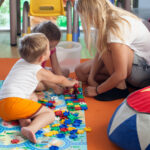In day-care settings, De Houwer and Pascal (2021) recommend that educators actively value all of the home languages. This doesn’t mean you have to know all of the languages or teach these languages in the day care setting. It does mean showing that you are open to all languages and the cultures associated with them. They suggest the following self-reflection questions:
- Do you speak clearly to a child? Keeping your message simple but grammatical and making use of natural gesture, pointing, facial expression to support successful communication.
- Do you make use of context and pictures/photos/drawings to teach the child new content/words?
- Do you respond supportively to what a child says, in any language?
- Do you give the child the time they need to form a sentence or do you speak for them and/or finish their sentences?
Their suggestions for promoting cultural & linguistic well-being include:
- Tell children that it’s really great that they can speak English, Kurdish, Russian, etc. because all languages are equal!
- Learning the words for “hello” or “good morning” in the children’s home languages to help new children feel welcome when they arrive at child care or preschool. You could learn how to say “thank you” and “good bye” too for when they are going home. “See you tomorrow’ would be lovely too!
- Build relationships with the parents and grandparents, maybe through a breakfast event where everyone brings something small to eat and share or through intercultural theme weeks or through a parents’ café.
- An archive with the most important words and picture cards in the languages relevant to the institution can be built up in your setting. In this way, all educators can access it and, if necessary, teach the children new words for already known content more easily. There are some great archives already for example at Omniglot and Transla https://transla-program.org/en/multilingual/
- Invite (grand)parents to come to the centre at a certain time and read short stories, sing songs, recite rhymes, or perform dances in one of the languages available in the children’s group and think about making this a regular occurrence.
- Design your rooms in such a way that language diversity becomes visible, for example through posters and murals with people from different cultures and with characters from different languages.
- Make different languages and cultures tangible through the selection of materials and media, for example, bilingual children’s books as well as songs and music in all of the children’s languages.
If you like this post, please share it!
Let’s get talking!
MP
What I read so you don’t have to:
Axelrod Y, Cole MW. ‘The pumpkins are coming…vienen las calabazas…that sounds funny’: Translanguaging practices of young emergent bilinguals. Journal of Early Childhood Literacy. 2018;18(1):129-153. doi:10.1177/1468798418754938
De Houwer, A. & Pascall, M. (2021). Our children and their languages: barriers, needs and opportunities: A proposal for early multilingual education KITA Handbook https://www.kindergartenpaedagogik.de/fachartikel/bildungsbereiche-erziehungsfelder/sprache-fremdsprachen-literacy-kommunikation/unsere-kinder-und-ihre-sprachen-huerden-beduerfnisse-und-chancen/
Gort, M., Pontier, R.W. & Sembiante , S. (2012) Function, Type, and Distribution of Teacher Questions in Dual-Language Preschool Read Alouds, Bilingual Research Journal, 35:3, 258-276, DOI: 10.1080/15235882.2012.734262
Gort, M. & Pontier, R.W. (2013). Exploring bilingual pedagogies in dual language preschool classrooms, Language and Education, 27:3, 223-245, DOI: 10.1080/09500782.2012.697468
Khalfaoui, A., García-Carrión, R., & Villardón-Gallego, L, (2021). A Systematic Review of the Literature on Aspects Affecting Positive Classroom Climate in Multicultural Early Childhood Education. Early Childhood Education Journal, 49: 71-81.
Langaloo, A., Lara, M., Deunk, M., Klitzing, N. & Strijbos, JW. (2019). A systematic review of teacher-child interactions with multilingual young children. Review of Educational Research 89(4): 536-568.
Zheng, Z., , Degotardi, S., & Djonov, E. (2021). Supporting multilingual development in early childhood: A scoping review. International Journal of Educational Research 110.

